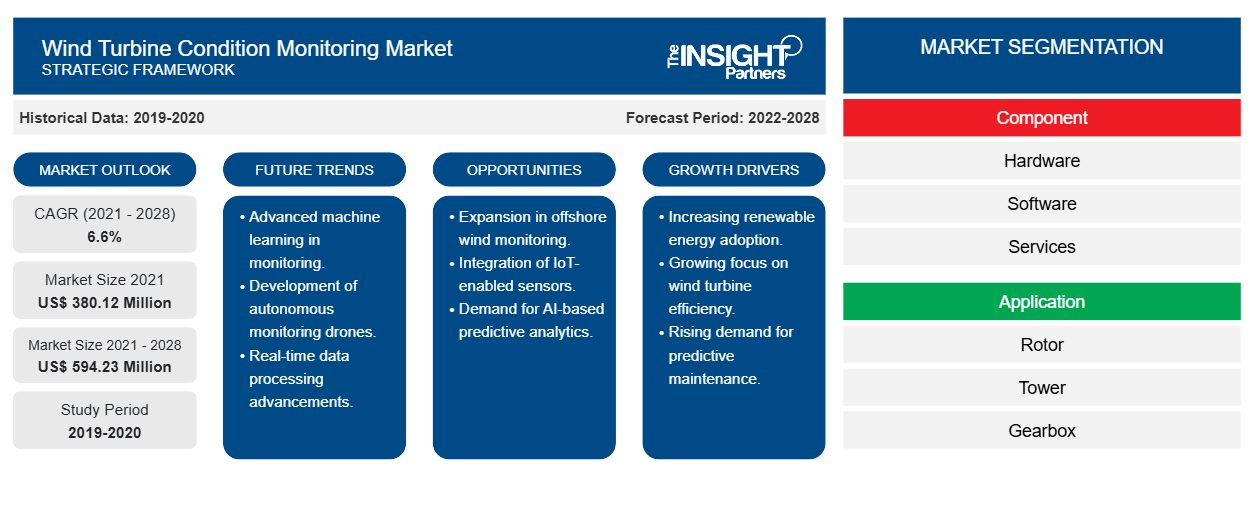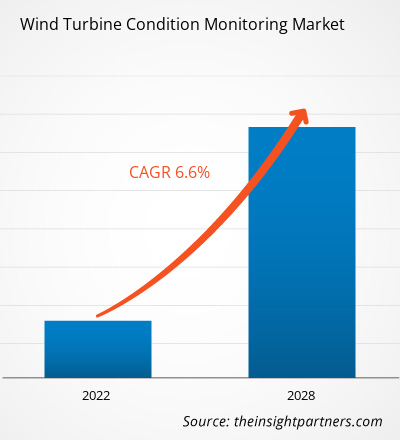The wind turbine condition monitoring market is expected to grow from US$ 380.12 million in 2021 to US$ 594.23 million by 2028; it is estimated to grow at a CAGR of 6.6% during 2021 to 2028.
The need to reduce greenhouse gas emissions and boost the amount of renewable energy in the energy mix prompted the development of offshore wind farms. There has been a considerable movement toward renewable and green energy in the energy sector to reduce carbon emissions, deplete fossil fuels, climate change, and others. This is driving the growth of wind turbine condition monitoring market.
The renewable energy demand will continue to climb due to dropping technology costs, the growing need to reduce CO2 emissions, and rising energy consumption in developing and underdeveloped countries. According to the International Renewable Energy Agency (IRENA), the share of renewables in annual global energy generation must climb from 25% to 86% by 2050, and the world will be needed to invest US$ 110 trillion in the sector by 2050, up from the US$ 95 trillion expected by 2030. As a result, there will be a noticeable shift from fossil fuels and renewable energy sources. In Europe, there are many offshore windmill projects in operation, accounting for 90% of total power generation. This is further fueling the growth of wind turbine condition monitoring market.
The growing inclination towards renewable clean energy is a significant driving factor for the growth of the wind turbine condition monitoring market worldwide. The wind turbine condition monitoring market is mature in developed nations and is growing substantially in many developing countries. Due to the high output and long-term expansion of wind farms, the installation of offshore wind turbines is on the rise. Additionally, the growing global population and increasing disposable income in developing countries are driving energy consumption. However, the wind turbine condition monitoring market's growth is hampered by the high cost of offshore wind farm installations. The wind turbine condition monitoring system facilitates an accurate shaft bending, shaft signature or profile, torsional vibration of the shaft, shaft torque, shaft rpm, and shaft power measurement. These systems are widely utilized for the early detection of failures or faults and also help in maximizing productivity and minimizing downtime, thereby increasing the growth of the wind turbine condition monitoring market.
You will get customization on any report - free of charge - including parts of this report, or country-level analysis, Excel Data pack, as well as avail great offers and discounts for start-ups & universities
Wind Turbine Condition Monitoring Market: Strategic Insights

-
Get Top Key Market Trends of this report.This FREE sample will include data analysis, ranging from market trends to estimates and forecasts.
Impact of COVID-19 Pandemic on Wind Turbine Condition Monitoring Market
North America has the highest rate of advanced technology adoption due to favorable government policies fostering innovation and enhancing infrastructural abilities. The COVID-19 pandemic had several implications for the renewable energy sector in the region. Wind power-generating facilities had reduced activity, including shutting down construction, operations, and maintenance projects at several locations, due to the implication of lockdown. Across the wind energy industry, these quarantine measures and shutdowns caused furloughs and layoffs of technical, construction, and manufacturing personnel, as well as project demobilizations in many cases. As a result, many solar and wind farms struggled to keep up with maintenance and operations. Furthermore, the COVID-19 pandemic made it more difficult for renewable energy producers to get project finance or equity capital. As a result, the COVID-19 pandemic negatively influenced the North American wind turbine condition monitoring market.
Wind Turbine Condition Monitoring Market Insights
Technological Advancement in Wind Turbine Manufacturing and Monitoring
Longer blades and taller towers, two of the most critical aspects in increasing wind turbine productivity, are driving the next-generation research and development effort to create a more powerful, efficient, durable, and cost-effective turbine. Other significant advancements include the creation of intelligent turbines that gather and understand real-time data and the modeling and adjustment of wind plant flows and turbine layouts to optimize wind harvest. The Wind Energy Technologies Office (WETO) collaborates with the industry to improve the performance and dependability of next-generation wind technologies while lowering wind energy costs. Further, the Wind Energy Technologies Office and the Advanced Manufacturing Office of the US Department of Energy are collaborating with public and private groups to use additive manufacturing, also known as 3D printing, to produce wind turbine blade molds. The traditional blade design method necessitates the development of a plug, or a full-scale model of the finished blade, which is then utilized to create the mold. The plug is one of the most time-consuming and labor-intensive operations in manufacturing wind turbine blades. Thus, 3D printing saves these valuable resources. Wind industry technology must continue to progress to secure future industry growth, building on previous triumphs to improve dependability, boost capacity factors, and lower costs. Modern wind turbines are becoming more cost-effective and stable, and their power ratings have increased to multi-megawatt levels. Therefore, the rising technological advancements and modernization in the wind turbine condition monitoring system will create numerous market opportunities.
Component-Based Market Insights
Based on component, the wind turbine condition monitoring market is segmented into hardware, software, and services. Anemometer, displacement sensor, data acquisition systems, and accelerometer are widely used in monitoring the condition of the wind turbine. Condition monitoring tool helps monitor the health of the wind turbine components and associated electrical systems. These tools help wind farm operators and owners replace components whenever necessary by predicting maintenance issues. For instance, KK Wind Solutions offers versatile data acquisition and analyzing units, which can be placed in the wind turbine's nacelle. These data acquisition and analyzing units collect data from various connected accelerometers and sensors and transfer the analyzed information. Vibration-based condition monitoring systems are among the most established systems used to monitor the drivetrain in the wind turbine. The sensors used for vibration-based condition monitoring include velocity transducers, accelerometers, and displacement or distance transducers.
Application-Based Market Insights
Based on application, the wind turbine condition monitoring market is segmented into rotor, tower, gearbox, generator, and others. The basic function of the gearbox in the wind turbine is to transfer energy from the rotor to the generator. Due to frequent braking and variable wind speeds, the load fluctuates, which causes a lot of wear on the moving parts. Components of the wind turbine gearbox are typically monitored with vibration sensors. As the resonance of the bearings is particularly in multi-kHz, vibration sensors that perform in the realm of around 10 kHz and above are usually suggested to monitor the high and low-speed shafts. The datum wind turbine condition monitoring system is designed to detect and prevent gearbox failures. With accurate real-time monitoring and analysis, staff schedules can be consulted, and repairs can be conducted at an early stage, which helps in cost savings. Sweden is a global leader in de-carbonization as it aims to be carbon neutral by 2045, and the energy sector aims to achieve 100% renewable electricity generation by 2040. The contribution of wind energy is steadily rising in the county as the country aims to harness 50TWh of energy from wind by 2024. Thus, the growing inclination towards renewable energy accelerates the requirement for respective vibration sensors.
Players operating in the wind turbine condition monitoring market adopt strategies such as mergers, acquisitions, and market initiatives to maintain their positions in the market. A few developments by key players are listed below:
- In 2022, The National Offshore Wind Research & Development Consortium (NOWRDC) has awarded two GE research projects: one focused on establishing a robust joining technique for big iron castings and another on the use of an Autonomous Inspection Vessel (AIV) for offshore wind turbines.
The regional trends and factors influencing the Wind Turbine Condition Monitoring Market throughout the forecast period have been thoroughly explained by the analysts at The Insight Partners. This section also discusses Wind Turbine Condition Monitoring Market segments and geography across North America, Europe, Asia Pacific, Middle East and Africa, and South and Central America.
Wind Turbine Condition Monitoring Market Report Scope
| Report Attribute | Details |
|---|---|
| Market size in 2021 | US$ 380.12 Million |
| Market Size by 2028 | US$ 594.23 Million |
| Global CAGR (2021 - 2028) | 6.6% |
| Historical Data | 2019-2020 |
| Forecast period | 2022-2028 |
| Segments Covered |
By Component
|
| Regions and Countries Covered |
North America
|
| Market leaders and key company profiles |
|
Wind Turbine Condition Monitoring Market Players Density: Understanding Its Impact on Business Dynamics
The Wind Turbine Condition Monitoring Market is growing rapidly, driven by increasing end-user demand due to factors such as evolving consumer preferences, technological advancements, and greater awareness of the product's benefits. As demand rises, businesses are expanding their offerings, innovating to meet consumer needs, and capitalizing on emerging trends, which further fuels market growth.

- Get the Wind Turbine Condition Monitoring Market top key players overview
The global wind turbine condition monitoring market is segmented on the basis of component and application. Based on component, the wind turbine condition monitoring market is segmented into hardware, software, and services. Based on application, the wind turbine condition monitoring market is segmented into rotor, tower, gearbox, generator, and others.
Advantech Co. Ltd., Baker Hughes Company, ENVISION Group, ENERCON GmbH, goldwind.com, General Electric, NORDEX SE, Siemens Gamesa Renewable Energy, TÜV Rheinland, and Vestas are a few key wind turbine condition monitoring market players considered for the research study. In addition, several other significant wind turbine condition monitoring market players have been studied and analyzed in this research report to get a holistic view of the global wind turbine condition monitoring market and its ecosystem.
Frequently Asked Questions
Which are the major application for Wind turbine conditioning monitoring?
What are reasons behind wind turbine conditioning monitoring market growth?
Which are the major companies in the wind turbine conditioning monitoring market?
Which Type is expected to dominate the market in the forecast period?
What are market opportunities for wind turbine conditioning monitoring market?
Which region has dominated the wind turbine conditioning monitoring market?
- Historical Analysis (2 Years), Base Year, Forecast (7 Years) with CAGR
- PEST and SWOT Analysis
- Market Size Value / Volume - Global, Regional, Country
- Industry and Competitive Landscape
- Excel Dataset
Recent Reports
Related Reports
Testimonials
Reason to Buy
- Informed Decision-Making
- Understanding Market Dynamics
- Competitive Analysis
- Identifying Emerging Markets
- Customer Insights
- Market Forecasts
- Risk Mitigation
- Boosting Operational Efficiency
- Strategic Planning
- Investment Justification
- Tracking Industry Innovations
- Aligning with Regulatory Trends





















 Get Free Sample For
Get Free Sample For